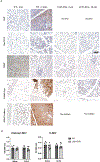Development and expansion of intramuscular adipose tissue is not dependent on UCP-1-lineage cells in mice
- PMID: 37203780
- PMCID: PMC10657332
- DOI: 10.1002/jor.25627
Development and expansion of intramuscular adipose tissue is not dependent on UCP-1-lineage cells in mice
Abstract
Accumulation of adipose tissue within and outside of skeletal muscle is associated with orthopedic injury and metabolic disease, where it is thought to impede muscle function. The close juxtaposition between this adipose and myofibers has led to hypotheses that paracrine interactions between the two regulate local physiology. Recent work suggests that intramuscular adipose tissue (IMAT) may have features of beige or brown fat, indicated by the expression of uncoupling protein-1 (UCP-1). However, this is contested by other studies. Clarification of this point is needed to inform our understanding of the relationship between IMAT and muscle health. To achieve this, we examined the effects of constitutive UCP-1+ cell ablation (UCP1-DTA) on IMAT development and homeostasis. IMAT developed normally in UCP1-DTA mice, with no significant differences in quantity compared with wild-type littermates. Likewise, IMAT accumulation in response to glycerol-induced injury was similar between genotypes, with no significant differences in adipocyte size, quantity, or dispersion. This suggests that neither physiological nor pathological IMAT express UCP-1 and that the development of IMAT does not depend on UCP-1 lineage cells. In response to β3-adrenergic stimulation, we find minor, localized UCP-1 positivity in wildtype IMAT, but the bulk of the adipocytes are unresponsive. In contrast, two depots of muscle-adjacent (epi-muscular) adipose tissue have reduced mass in UCP1-DTA mice and UCP-1 positivity in wildtype littermates, comparable to traditional beige and brown adipose depots. Taken together this evidence strongly supports a white adipose phenotype for mouse IMAT and a brown/beige phenotype for some adipose outside the muscle boundary.
Keywords: muscle; pathophysiology; progenitors and stem cells.
© 2023 Orthopaedic Research Society.
Figures





References
Publication types
MeSH terms
Substances
Grants and funding
LinkOut - more resources
Full Text Sources
Research Materials

